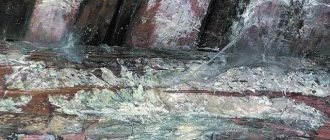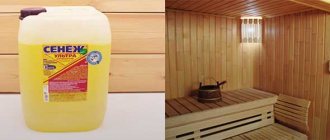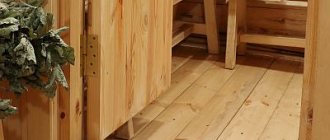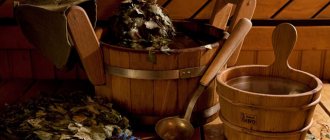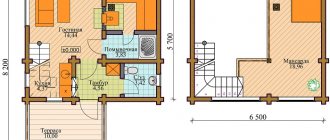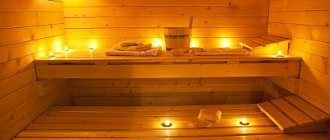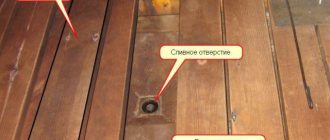A wooden residential building often suffers from various kinds of misfortunes. Harmful underfloor fungus is one of the most common problems plaguing the lives of homeowners. The spread of fungus in the house usually begins in the basement or cellar.
Why does mold form under the floor and in the underground of a wooden house?
Fungus appears under the floor for a reason. Causes:
- The difference in temperature between an unheated and/or unheated basement and home causes condensation to accumulate and excessive humidity. And in a humid environment, mold develops.
- Poor ventilation. The fungus feels very comfortable in moldy, still air.
- Lack of antiseptic treatment of the materials from which the subfloor is made. Wooden parts of the structure are especially susceptible to mold and rot.
- The fungus can spread to the walls and floor of the basement from food stored there if it is infected.
Why does the board turn black?
There are many reasons for the appearance of black fungus on boards:
- poor ventilation in the room;
- high humidity;
- sudden changes in temperature;
- condensation formation;
- low-quality wood;
- contamination of building materials by fungal colonies;
- prolonged contact with damp soil.
Why is black mold on boards dangerous? Black fungus is dangerous not only because of its rapid spread, but also because of its negative impact on people and animals that are forced to inhale the spores. Black mold on lumber that is used to build a house or for interior decoration of residential premises can lead to contamination of absolutely all surfaces. In this case, the damage can be so serious that complete dismantling of wooden structures will be required.
Harm from mold to property and human health
Mold visible to the naked eye under the floor of a wooden house may be the initial stage of a fungal infection. However, wooden floors, ceilings, and walls are destroyed very quickly under the influence of fungus. One day, and this is not the best day at all, the house may simply collapse.
Attention! Mold spores are microscopic in size and travel long distances. In a short time, under favorable conditions, a large area can become infected with the fungus.
Fungus under the floor causes dangerous diseases for humans, pets and indoor plants. Possible exacerbation of chronic ailments, development of allergies, rheumatoid and heart diseases, respiratory diseases, up to the development of bronchial asthma.
Conclusion
Mold appears due to excess humidity, poor ventilation, and freezing of parts of the house.
- You need to start fighting the fungus when the first signs appear: odor, high humidity, plaque.
- You need to remove the layer of mold from wood or concrete using a tool (for small areas you can use a chemical), and then dry the surface.
- The remainder must be treated with one of the antiseptics, following the instructions.
- For prevention, it is necessary to exclude the formation of moisture and ensure ventilation.
By following the rules, you can get rid of mold quickly and effectively. If the causes are eliminated and preventive measures are taken, there will no longer be a need to fight the fungus.
How to get rid of mold under the floor and in the underground of a private house?
The basement, cellar, and space under the floor of a wooden house most often suffer from the effects of harmful fungus.
How to get rid of mold on boards and joists?
If mold and rot are found under a wooden floor, the question of how to get rid of it is very pressing. If there are more than half of the gears on the boards, they should be replaced with new ones.
If the fungus is visible only on the surface, then:
- the infected top layer must be removed with a scraper or a stiff metal brush;
- moisten the boards generously with an antiseptic solution or the same copper sulfate and leave for several hours;
- bleach twice with Bordeaux mixture.
Anti-mold agents and their use
A lot is known about the means that can be used to treat a cellar.
- One of the most common tips on how to get rid of fungus in the basement of a wooden house is with the help of a folk remedy such as copper sulfate. Dilute 100 g of powder in a bucket of clean warm water. The solution is applied with a wide brush and a roller to the walls, floor, and ceiling of the basement and left to soak. Treatment must be repeated after a month.
- Lime is a long-known and well-proven folk remedy. 500 g of lime are mixed with 10 liters of water. To enhance the effect, you can add 200 g of formaldehyde. The liquid is applied with a roller or brush to shelves, floors, and walls. You can use a spray gun.
- Chlorine is an effective remedy for underground mold. Dilute “Whiteness” with chlorine bleach with water; the solution should be concentrated. First remove the mold mechanically, then thoroughly wet the surfaces with bleach.
Attention! Chlorine fumes are very toxic to people and animals. Observe personal protective measures and wear a respirator. Ventilate the room well.
- A combustible sulfur stick will eliminate any mold, as well as moss, which can appear even in a damp basement. It is better to put the saber in a metal container or tray, set it on fire and quickly leave the basement. After 12 hours, the cellar is opened, ventilated and dried.
Attention! To achieve the effect when using a sulfur corrector, it is necessary to close ventilation pipes, windows, and cracks in the basement.
- Also among folk methods can be noted treatment with solutions of vinegar, boric or citric acid, sodium chloride, ammonia, and tea tree oil. However, they are time-consuming and less effective than the ones above.
- A modern method of treating any pathogenic microorganisms is treatment at high temperatures using a microwave apparatus. The advantage of this method is that it is safe for people and pets, but is performed only by specialized organizations.
Waterproofing, treatment and wall covering
It is impossible to remove mold in the basement of a log house without waterproofing the foundation. The process is labor-intensive, but necessary:
- The bottom of the cellar is visible, clean.
- The clean foundation is then waterproofed. You can use different materials:
- polymer membrane;
- bitumen mastic;
- roofing felt;
- ready-mixed coatings, etc.
- Drainage pipes are being laid.
- Geotextiles are laid.
- The last stage is puttying and filling the blind area.
Ventilation
It is impossible to solve the question of how to get rid of mold in the cellar without a high-quality ventilation device. The battle will not be successful if dry air is not provided in the basement of the house.
The easiest way to organize supply and exhaust ventilation is to install two pipes of the same diameter in opposite corners of the basement.
- The first pipe - the supply pipe - is installed half a meter from the floor level in the basement. The top end is above the foundation.
- The hood is placed in the upper corner of the cellar and rises 0.5 m above the ridge; it must be insulated (for example, with mineral wool) to avoid condensation accumulation.
- The outer ends of the tubes are covered with visors.
The pipe material can be any: PVC, reinforced concrete, metal, plastic.
How to fill the underground from dampness?
To get rid of fungus and prevent it from appearing in your basement or log home subfloor, follow a simple technique.
- The first step is to get rid of the top layer of underground soil. It should be removed approximately 20 cm to remove all the overgrown mold mycelium.
- Then you can fill the soil with a solution of copper sulfate for disinfection, let it soak, then pour a layer of lime (1–2 cm).
- The next layer is geotextile.
- A cushion of sand and gravel is laid on it.
- Lay the next layer with a thick waterproof film or roofing felt.
- You can mount logs and lay a wooden floor.
As an option, you can cover the base with expanded clay, which absorbs moisture.
Types and signs of fungal formations
Mold and fungi are the simplest forms of microorganisms that have long existed in nature. The following types of fungus develop on wooden surfaces:
- House sponge;
- White house fungus;
- Basement fungus.
Such formations pose a hidden danger not only to modern coatings, but also to human health. Fungal spores provoke frequent headaches, difficulty breathing, night cough and allergic reactions.
The spread of fungal formations is accompanied by the appearance of the first signs:
- Strong smell of dampness;
- Brown, black, dark gray and white spots with uneven edges and their further darkening;
- Moistened areas of the floor covering with color fading;
- Blistering, cracking and falling of the plaster layer.
In order to take effective measures to eliminate fungus on a wooden base, it is necessary to find out the main reasons for its appearance.
Prevention measures
After the fungus in the cellar has been destroyed, care must be taken to ensure that it does not reappear. Preventive measures will help with this.
- Insulate the building and install waterproofing.
- Make a plan to regularly inspect areas where excess moisture may occur, paying particular attention to corners, joints, and areas where sunlight does not penetrate or occurs very rarely.
- Ventilate the basement and avoid moisture.
- Treat all surfaces, both wood and other materials, with a fungicidal antiseptic.
If you are in the process of building, follow the advice and be careful in advance to prevent fungus from taking up residence in the house.
- A ventilation device will help avoid problems with humidity. If it is impossible to design a supply and exhaust system, at least make windows for ventilation. It’s good if sunlight also penetrates through them.
- Insulate the foundation and waterproof the basement and subfloor.
- Construction materials must be treated with an antiseptic.
- It’s good if the basement has heating.
Professional products
The chemical industry has also produced a large number of different preparations to eliminate the smell of rot and remove fungus. But they are often very expensive due to complex components and marketing hype.
- "Boramon" is great for treating any surface.
- “Mellerud” almost instantly kills the fungus and its spores, while the drug easily penetrates the porous structure of the surface being treated.
- "SZAVO" is suitable for combating any types of fungi. Conducts not only successful disinfection, but also has protective properties. Does not require preliminary surface preparation.
You can continue to list industrial products, but different regions have different assortments, and you are unlikely to order from the Internet.
Let us remind you that the instructions given on the packaging must be followed (with all precautions).
Perhaps you should contact a special service that deals with the sanitation of premises. They have serious equipment, for example:
- Microwave, which allows you to quickly dry contaminated surfaces (using ultrahigh frequencies)
- Special vacuum cleaners for water.
- Mobile dehumidifiers.
Cleaning companies use innovative methods and use instant disinfectants to quickly remove lesions. So serious work should be entrusted to specialists . It is acceptable if the company is well-known and has guarantees.
Where does it appear?
Aspergillus is a fairly unpretentious resident, which makes it almost ubiquitous. However, there are surfaces on which the appearance and active proliferation of fungus is most likely. There are several of them.
- Plastic. PVC windows store heat, have a high degree of sound insulation and at the same time are excellent for the life of black mold (moisture does not evaporate).
If PVC windows are constantly closed, the appearance of fungus cannot be avoided - Drywall. The material is convenient and popular in construction, but it absorbs moisture, which does not evaporate. It is important to follow the installation technology here: slabs that are not completely dried will become a source of mold.
Mold on drywall - Concrete. Most often these are floors (floors, walls). If designers or builders make mistakes, the joints between walls, especially corners, are exposed to precipitation and cold.
Mold on the walls - Technique. These are appliances that come into contact with moisture: refrigerator, washing machine, split system/air conditioner, air humidifiers. If these devices are used incorrectly, there is a possibility that black mold will settle there too. It is advisable to keep the equipment dry; wipe wet parts often.
Mold in the washing machine - Wardrobe items. This will happen if the laundry is stored in sealed boxes or damp cabinets. Most often, we simply break the rule of dryness: under no circumstances should we put away things that are not completely dried!
Fungus can even appear on clothes
Recommendations for treating surfaces affected by fungus
You can use one of the previously described remedies or prepare another. For example, you can mix 1 cup of borax and 4 quarts of water in a large bucket, pour the solution into a spray bottle, and spray small areas with it. Large areas must be treated with a brush and mop. Blot the floor with this liquid. Wait about 10-15 minutes and scrub the floor with a brush. Blot it again with the solution and repeat again.
If necessary, the same solution can be used to treat parquet boards. Vacuum the floor thoroughly to remove dead mold. Wet the coating and floor again with a small amount of the solution and leave to dry for a couple of days. To help the areas treated with the solution dry faster, turn on the air conditioner or heater.
Borax will prevent the fungus from reoccurring. Replace baseboards and flooring. Before bringing things back into the house, treat them with a solution of borax and water.

